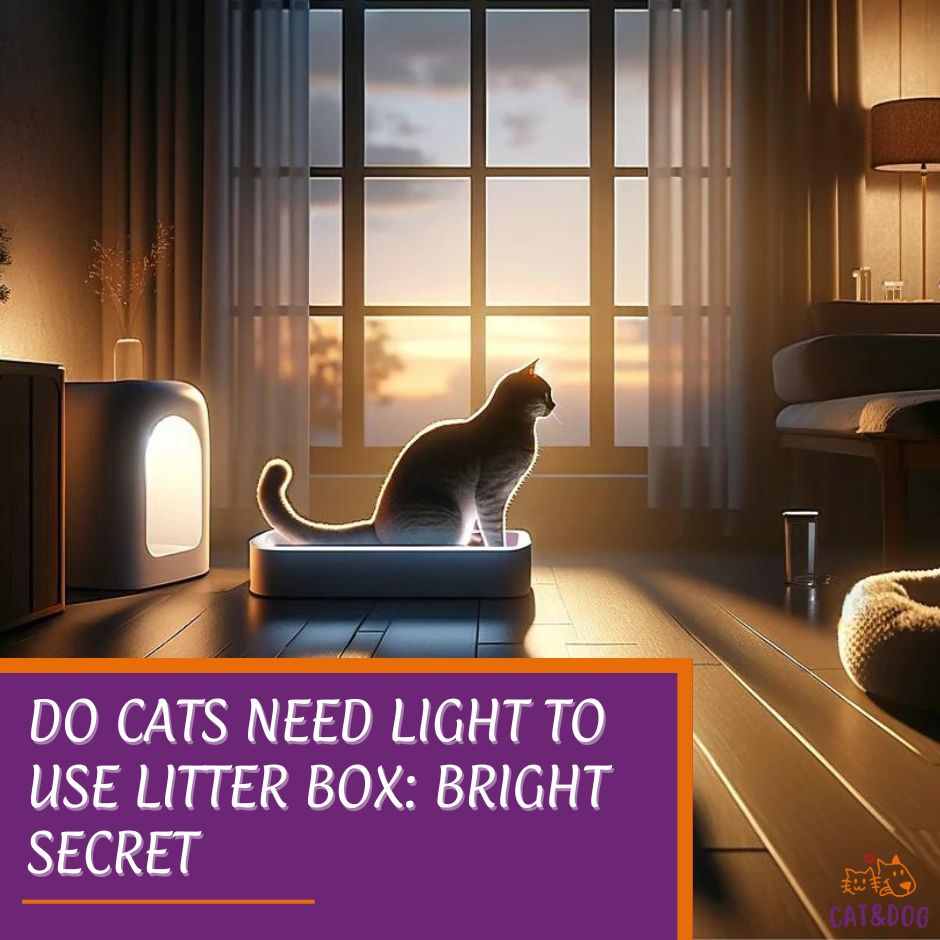Pet parents, it’s probably crossed your mind “Do cats need light to use litter box?” As a cat owner, you’re likely in tune with the peculiar habits and needs of your whiskered companion.
Cats have excellent night vision, so they do not necessarily need light to find and use their litter box. (1)
However, providing enough light near the litter box can help cats feel more comfortable and confident using it at night, especially if the litter box is in a dark or unfamiliar location or low-light conditions.
Additionally, it’s important to keep the litter box clean and well-maintained to accommodate your cat’s bathroom habits.
Regular cleaning and scooping will help maintain a comfortable environment for your cat to do their business, and having adequate lighting in the area is crucial for their comfort and confidence, as cats do need a certain amount of light to see.
This is especially important for cats, as they rely heavily on their sense of smell to locate their litter box and feel comfortable using it during nighttime hours.
Cats, with their enigmatic ways, often stir up quite the conversation on what exactly they need to lead a happy indoor life.
We’re about to dig into the essentials of feline nocturnal habits and reveal whether darkness throws a wrench in their bathroom routine.
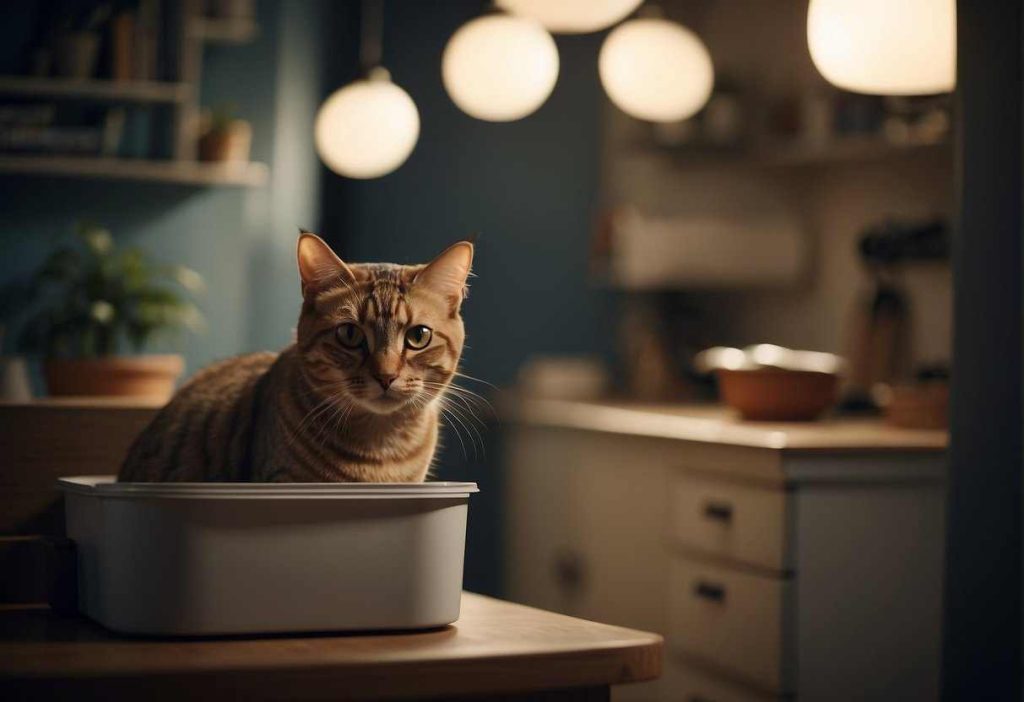
Cats are indeed fascinating creatures with eyes that seem to pierce through the shadows, but does this mean a pitch-black room is no challenge for them?
Well, the truth lies in the extraordinary vision that allows them to see in low-light conditions. However, just because they can, doesn’t always mean they’re comfortable. (2)
In this article, we’ll combine expert insights and practical tips to ensure your cat’s litter box usage is up to scratch day or night. We’ll untangle this mystery with a splash of humor and straightforward guidance.
Get ready to understand the lighting needs linked to litter boxes that could make a world of difference for your cat.
Key Takeaways
- Cats can use a litter box in low light but may prefer some illumination.
- Proper lighting can enhance comfort and accessibility for litter box usage.
- Consider your cat’s age and health when tailoring litter box lighting.
Do Cats Need Light to Use Litter Box: The Role of Lighting

Cats are known for their exceptional night vision, but when it comes to litter box usage, many cat owners ponder whether their feline friends require a bit of light. (3)
Reviewing Scientific Research and Studies
Cats’ eyes are adept at functioning in low light due to their large corneas and pupils.
Studies indicate that while cats don’t require bright lights, complete darkness isn’t ideal either. A soft glow from natural or ambient sources often suffices.
While ensuring the right lighting conditions for your cat’s litter box, consider also the benefits of using eco-friendly litters, which not only support your cat’s comfort and health but also contribute to environmental sustainability.
How Lighting Affects Your Cat’s Comfort and Safety
Could you imagine fumbling around in the dark trying to find the bathroom?
A well-placed nightlight can prevent such a scenario for cats, ensuring safety and comfort, especially for kittens or seniors.
Types of Lighting and Their Effects on Cats
- Ambient light: Subtle and natural, it’s enough for most cats.
- LED light: Energy-efficient and long-lasting, but choose a warmer hue to avoid discomfort. (4)
- Natural light: Perfect during the day, but not reliable at night.
Light intensity shouldn’t be blinding—think soothing, not spotlight.
Practical Lighting Solutions for Cat Owners
Here’s how to hit the sweet spot with litter box lighting:
- Place a small nightlight near the litter box.
- Opt for LED sensors that activate in low light.
- During the day, ensure the litter area receives natural light, but watch out for direct sunlight which can heat the litter.
In addition to ensuring proper lighting, opting for a hygienic litter solution that effectively manages odor and cleanliness can significantly enhance your cat’s litter box experience, making them feel more comfortable and secure, regardless of the lighting conditions.
Remember, every cat is unique, so observe and adjust as needed. Your cat’s comfort is key!
Enhancing Litter Box Accessibility with Proper Lighting
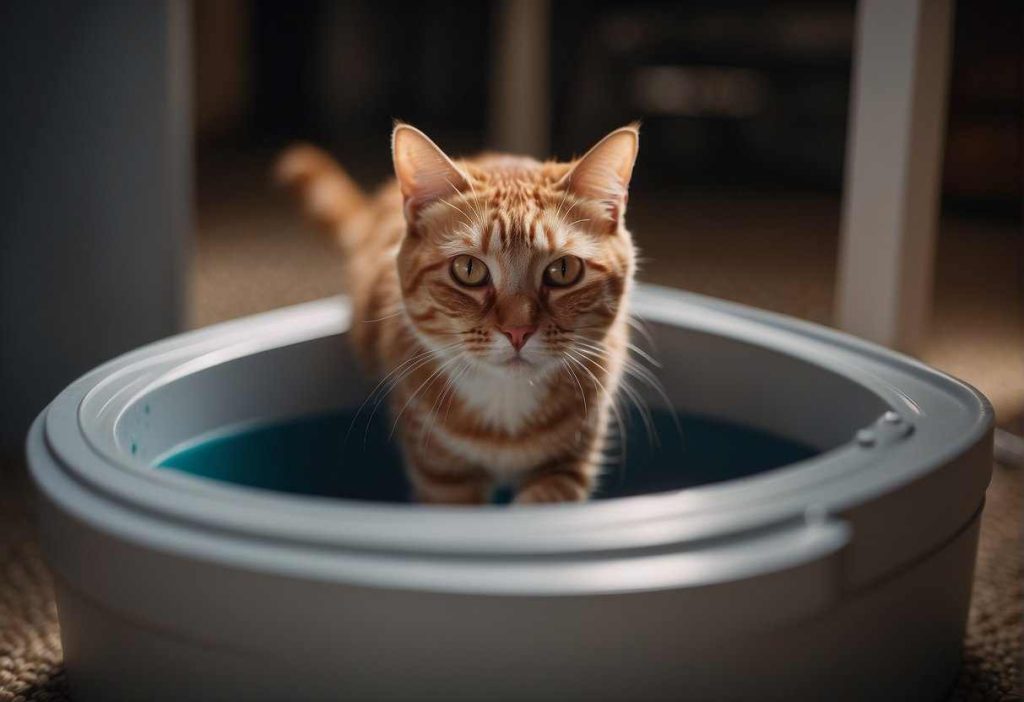
Best Practices for Litter Box Lighting
Let’s shine a light on some easy tips to make litter box visits a breeze:
- Keep it subtle: A small nightlight can provide just enough illumination without overwhelming your cat’s sensitive eyes.
- Strategic placement: Position the light source so it isn’t directly shining into the box—cats aren’t fans of the spotlight while they do their business.
Special Considerations for Cats with Unique Needs
Catering to your cat’s individuality is key:
- Kittens and Seniors: These little explorers and wise elders appreciate a guiding glow to find their toilet. (5)
- Visually Impaired Whiskers: Soft lighting can be immensely helpful for our sight-challenged pals. (6)
- Anxious Felines: Familiar and constant light can reassure those skittish at night—think of it as their cozy comfort.
Implementing Effective Lighting in Multi-Cat Households
Running a feline-friendly establishment? Keep harmony with these strategies:
- Mix and match: Some furballs might prefer a lit path while others don’t mind the dark. Try different setups to cater to their preferences.
- Territory matters: If you learn that shared spaces spark disputes, consider separate boxes with their lighting akin to personalized suites.
Just remember, when it comes to litter boxes, a little light can make a big difference for you and your whiskered roommates. Keep it cozy and gentle, and your kitty will thank you with purrs of relief!
Addressing Behavioral Signs and Solutions
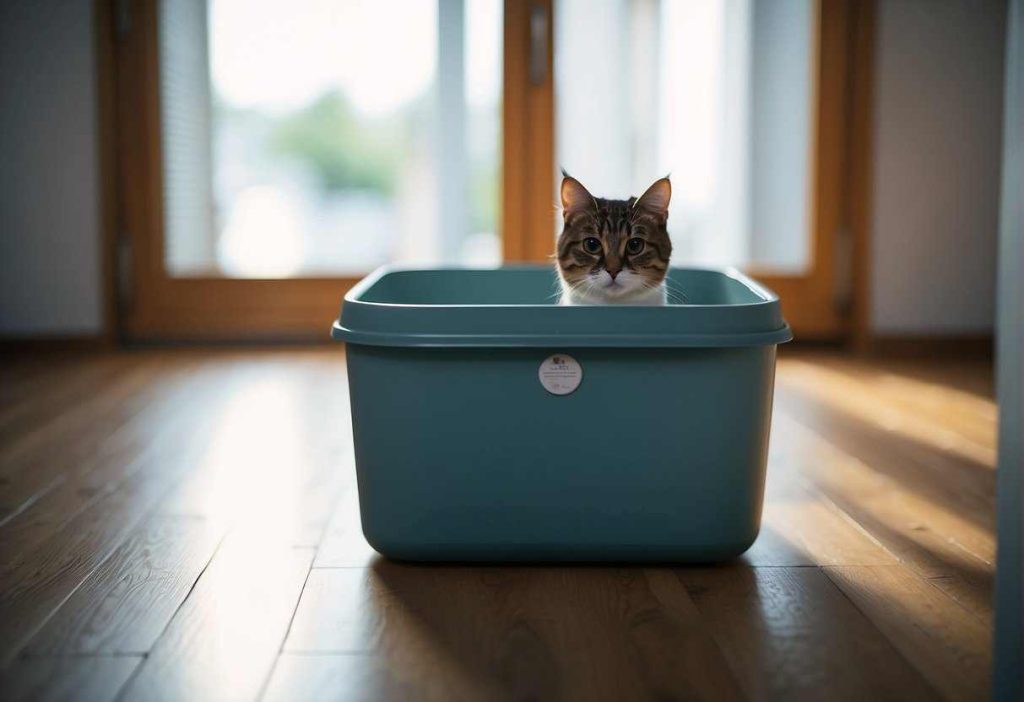
Understanding Behavioral Responses to Lighting
Do you see your whiskered companion hesitate before stepping into the litter zone? Or perhaps they seem perfectly at ease, sauntering in at any time of day or night. Watch for these behaviors:
- Comfort Signs:
- Smooth entry and exit from the box
- Regular use with no accidents
- Distress Signs:
- Reluctance to approach or enter the box
- Increased vocalization near litter area
Case Studies: Successful Lighting Strategies
Curiosity about real-life experiences? You’re not alone. Stories from other cat owners offer valuable insights:
Example 1: Twinkle Toes
- A friend used a soft night light.
- The cat named Twinkle began to consistently use the box at night.
Example 2: Shadow’s Tale
- One owner decided to go without a light.
- Shadow, their cat, showed no change in litter box usage.
Behavioral Solutions and Adjustments
If your kitty’s showing signs of litter box lighting woes, consider these fixes:
- Gradual Introduction:
- Slowly introduce light using dimmers or night lights.
- Consistency:
- Keep lighting consistent to avoid confusion.
Remember, each cat’s a unique little critter, so what works for one may not work for another. Keep an eye out for those tell-tale signs and tweak the lighting to suit your cat’s preference.
Your fluffy detective will thank you!
Understanding Your Kitties Litter Box Needs
Location, Location, Location! It’s crucial to pick the purr-fect spot for your cat’s loo. You see, cats have a rep for being picky, and the wrong spot might just lead to a ‘no-go’ situation. Here’s a quick rundown:
- Privacy: Cats enjoy a bit of seclusion. Think of it as their personal bathroom retreat. (7)
- Accessibility: Ensure it’s a breeze for your kitty to get to, especially for the young’uns and seniors.
- Lighting: While cats don’t need a spotlight, a faint glimmer (like from a window) can help at night. After all, they aren’t super cats that can see in absolute darkness.
Going by Instinct Cats innately prefer a clean, quiet area to do their business, mimicking their wild ancestors. Watch for these signals:
- Scratching and digging: It’s not just to cover up the evidence; it’s an instinctual ritual.
- Seeking seclusion: A little cover can give them the sense of security they need.
To keep your kitty content, consider a dim night light. It’s not essential, but it can be a nice touch to help senior cats or those a tad less confident in the dark. Remember, a happy cat means a clean home!
Practical Tips for Litter Box Management
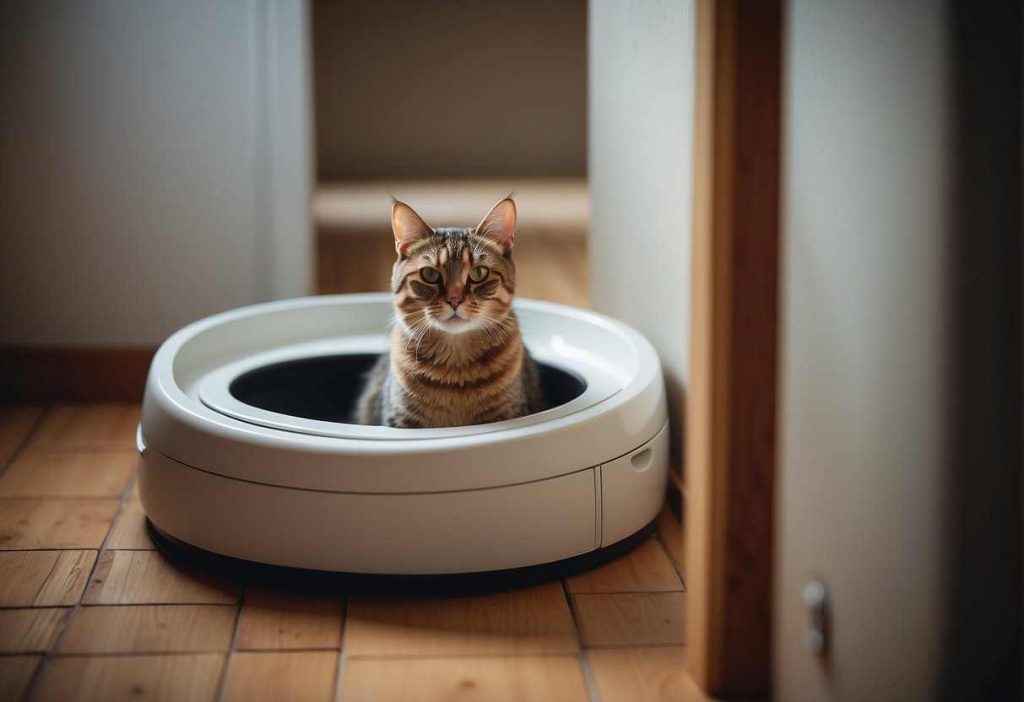
Choosing the Right Litter Box and Location
- Size: Make sure it’s roomy enough for your feline friend to turn around in.
- Style: Some cats love privacy, so a covered box might be spot on. Others prefer open-air setups—observe your kitty’s preference.
As a general rule, it is recommended to have one litter box per cat plus one more to ensure that each cat has a safe and comfortable option.
Maintaining Cleanliness and Hygiene
Cleanliness is next to catliness, right? Keep that litter box spick and span:
- Scoop Daily: Like checking your email, this one’s a no-brainer routine.
- Deep Clean Weekly: Roll up those sleeves—it’s bath time for the box.
- Stay Stocked: Always have an extra bag of fresh litter on hand, always.
Let There Be Light
- Proper lighting isn’t just for ambiance; it’s a practical tool:
- Spot spills and strays outside the box easier.
- Keep an eye on the litter’s condition—is it clumping correctly?
Keep things simple and your cat content. A well-managed litter box means a happy home with healthy paws padding around.
Quick Recap
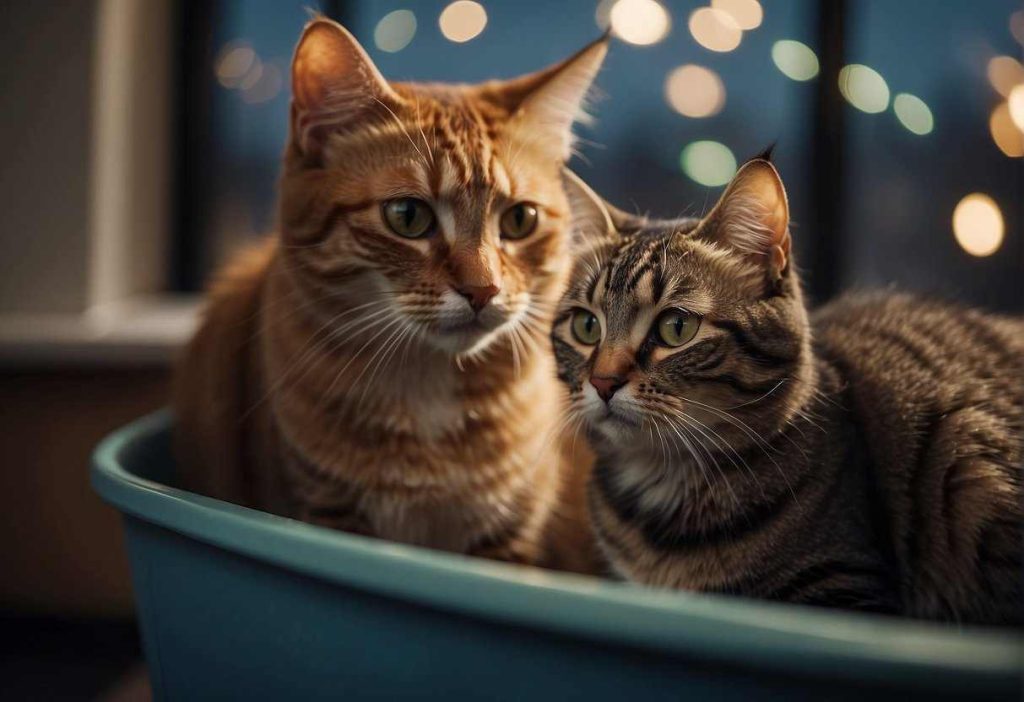
Let’s break it down:
- Lighting Preferences: While cats possess superior night vision, a study from the Journal of Feline Medicine and Surgery suggests that cats may prefer a well-lit area for their bathroom breaks.
- Owners’ Observations: Cat owners often report that their pets seem to manage just fine without additional lighting.
- Personal anecdotes indicate many kitties have no trouble using their litter boxes in the dark.
- Environmental Comfort: What’s the takeaway for you as a diligent pet parent?
- It boils down to the comfort and preferences of your particular cat.
- Some cats might not bother about lighting, while others might appreciate a softly lit path to their toilet.
Here’s the gist of creating a comfortable litter environment for your cat:
- Safety First: Ensure the path to the litter box is free of obstacles, especially if the area is dimly lit.
- Cleanliness: A light can help you spot any accidents or spills that need cleaning.
- Anxiety Reduction: A well-lit area may reduce stress for some cats, contributing to their well-being.
Remember, every cat’s preference can be as unique as their personality. Feel free to experiment with different lighting scenarios to discover what works best.
Watch your cat’s behavior; this will give you the best clues as to whether a nightlight turns out to be a bright idea!
Frequently Asked Questions
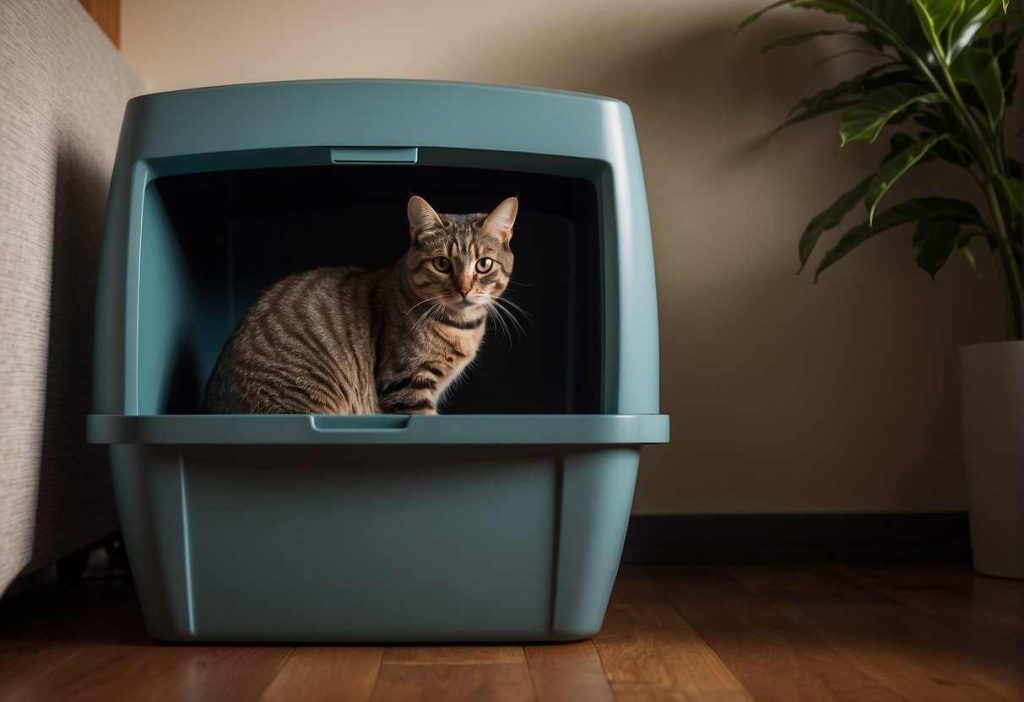
Navigating the ins and outs of your furry friend’s litter box habits can raise a lot of questions.
Whether you’re wondering about the best type of lighting or how to cater to an elderly cat’s needs, the following FAQs aim to shed some light on the subject for you.
Do cats prefer a lighted area for their litter box?
Absolutely! Just like you might prefer a little nightlight to make your midnight bathroom trips safer, your feline friend typically won’t shun a softly lit litter area.
Cats have excellent night vision, but a gentle light can enhance their comfort and assurance.
Can lighting affect my cat’s litter box habits?
It sure can. Cats are creatures of habit and any changes, including lighting, might lead to an adaptation period.
Ensuring the light is neither too bright nor completely absent can help maintain your cat’s regular routine.
What type of lighting is best for a cat’s litter box area?
Think soft and subtle. A dim nightlight or ambient lighting is perfect, providing just enough illumination without overwhelming your kitty’s sensitive eyes.
It’s the cozy middle ground.
How can I introduce my cat to a new lighting setup for their litter box?
Start gradually. Introduce the new light source at a low intensity and gradually increase to the desired level.
This lets your cat acclimate without stress and continue using their litter box with ease.
Are there any lighting solutions for cats with poor vision?
Definitely! For aging cats or those with vision issues, a slightly brighter light could be quite helpful.
Consider LED lights that emit a clear but not harsh light, ensuring that they can navigate comfortably.
Does the color or brightness of the light-matter for cats using the litter box?
While cats aren’t picky about color, they do appreciate a certain level of brightness.
Soft white or warm-toned light is generally preferred as it’s closer to the natural spectrum and less intrusive.
How can I use lighting to encourage my cat to use the litter box at night?
If your cat is hesitant to use the box at night, installing a motion-activated light might just do the trick.
This ensures the area is lit only when needed, which can encourage your cat to continue their nightly routine.

